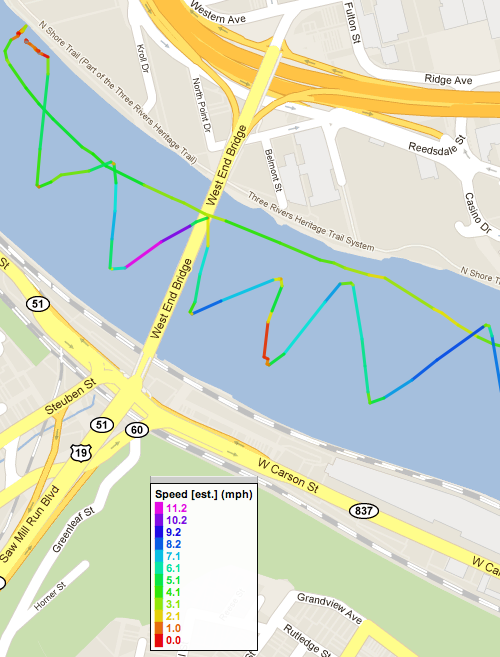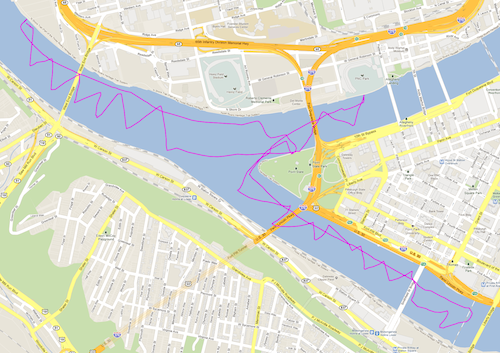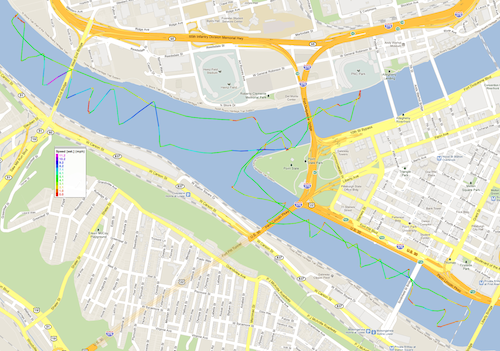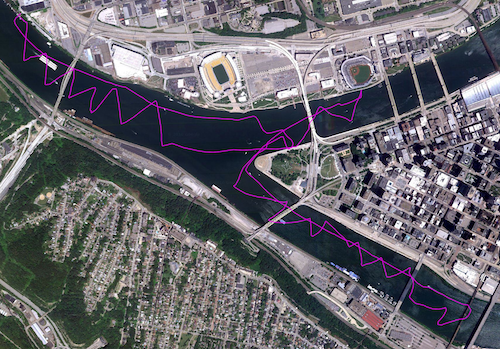The Big Boat
July 30, 2011
The big boat is in the water and we are ready to sail. This will be a social sail. We have a total crew of four at our launch and our plan is to sail to the Point, lose one crew member and gain two more.
It's been nearly four years since my son and I put this same boat into the rivers at the Birmingham Bridge launch on a windy September day in 2007. (gps track here.) It was a test to see first hand if sailing on the rivers was possible. The test went very well, partly due to our caution in picking a day with good winds and partly due to luck. Those winds happened to be blowing straight down the Mon on which we sailed. It was great and I was hooked on sailing on the rivers. On that first river sail, I was largely innocent of most of the complications of river sailing.
That was then. Now I have much broader experience of what can go right and what can go wrong in sailing on the rivers. All that experience of river sailing has been on a smaller boat. I am eager to see just how well that experience fares when I have the tiller of a bigger boat in my hand.
The conditions for sailing this day seemed very promising. The forecast called for light winds: 6-7 mph from the NNW. That would make for gentle and controlled sailing on the Ohio and Mon, where the winds could reach the river course with the least deflection. Sailing would be inconsistent, I expected, on the Allegheny, since buildings on the north shore would block the winds. Finally, river currents were too low to factor into our sailing. They were as linked here on the Allegheny, Mon, Yough and Ohio.
The actual conditions proved a little more erratic. The winds were in the 5-7 mph range, but fluctuated in direction from mostly NNW to sometimes as far east as NNE. Finding this fact later in the weather records was comforting. At the Point, the flag on Heinz Field gives a good indication of the wind direction. During our sail, I had seen it mostly indicating a NW wind. From time to time, it showed a NE wind. "Look!" I'd exclaim to our fellow sailors, trying to convince them that this was something strange and unexpected.
We set off at 3 pm for the Point on a gentle run, with the wind at our backs, blowing upstream. It was already apparent to me then just how much difference size makes. I'd gone from a 12 foot Hobie Bravo to a 16'7" Getaway--a little more than a third increase in length. Yet in the mild 5 or 6 mph winds, we were making much better way. We maintained an easy 5 mph. At that speed, the Bravo would be straining under the effort. The bigger Getaway seemed hardly to notice.
We passed the familiar landmarks: the West End Bridge, the casino, the Science Center submarine and more.
Soon we were cutting across the Allegheny...
... to dock at the Point. There we had a change of crew. Jim left us and my wife and daughter came on board.
We live very close to the Convention Center, which has a convenient dock higher up the Allegheny. However I'd predicted that the NNW winds would be too obstructed to let us sail up the Allegheny to dock at the Convention Center. The two had ridden their bicycles to the Point where they would connect with us. That we couldn't sail up the Allegheny proved to be a correct prediction and something I noted with smug satisfaction. Fortunately, my smugness was politely overlooked by everyone.
We returned to the rivers. The gps tracks tell the story:
We rounded the Point:
Then we approached the Fort Pitt Bridge:
It was around this time that Eve said, "You know, I like this boat much better than the little one." I can see why. This bigger boat has a spacious deck on which to stretch out. The little Bravo is cramped with two people. Worse, the little boat is less stable. It takes only a little too much wind and a slow hand on releasing the mainsheet for the crew to be tipped into the water.
We had a good run down the Mon to the Liberty Bridge. The winds on the Mon were much steadier, as expected for NNW winds.
Here's the moment we sailed under the Smithfield Bridge. (I lay on my back on the deck for this photo.)
This is our highest point up the Mon at the Liberty Bridge, where the river takes a turn. There the winds seemed to die. I was guessing that the turn brought too much of the northern shore in the way of the NNW winds of the day.
The journey back had us tacking into a headwind. The NNW winds were sufficiently misaligned with the exact direction of the river course to give us some erratic spots, where the wind was actually blowing from the West over the water. It didn't take so many tacks before we arrived at the Point again.
Since I'd seen some evidence of North Easterly winds, I thought it might be worth trying to sail up the Allegheny. We rounded the Point and tried to make our way. Here we are passing under the Duquesne Bridge heading up the Allegheny.
It did not go well. There were moments of good wind and moments of calm. But they were so disordered in both timing and direction that we soon gave up. We shed our passengers at various points on shore and turned for the marina.
It was on that return, with my son and I the only ones on board, that we had the best winds of the day.
The gps tracks affirm my general sense of how the performance of the Getaway and Bravo compare.
First is how closely the sailboats can sail to the wind. A sailboat can keep pointing its bow closer to the wind until it loses lift from the sail. At that moment, the sail starts to "luff." That is, it loses its smooth taught shape and starts to flap. The transition is akin to the stalling of an airplane wing. A jib sail helps forestall this transition. It is the small triangular sail at the front and its main function is to direct the flow of air smoothly over the main sail and to keep it smooth. The Getaway has a jib; the Bravo does not. So we would expect the Getaway to sail closer to the wind before its sails luff.
I've spent some time staring at this day's gps tracks and those made by the Bravo under similar conditions. The Getaway certainly sails as close to the wind as the Bravo, and probably a little closer. It is hard to see in the comparison tracks just how much closer the Getaway can sail.
While this first point of comparison can be disputed and debated, the second cannot. The big, unequivocal difference is speed. In good and steady winds, we were able to zoom at up to speeds at high as 11 mph on the speed plot above (the purple section of the plot below).

That speed is actually a little low. I happened to look at the gps receiver during this burst of speed and saw 12 mph recorded. These speeds were achieved easily in winds below the maximum that Getaway can handle. I expect the Getaway can go faster still. The Bravo, at its best, sails up at 8 or 9 mph.
Greater speed simply means that greater distances can be covered; or the same distance can be covered in a shorter time. That is for the better. If we are to host passengers, they are likely to have less patience than I for an hour's painstaking tacking into the wind, such as I often do with Bravo.
I've been mulling over the better performance of the Getaway and its ability to sail a little closer to the wind. I'm not so sure that it is simply a matter of the Getaway having a jib and the Bravo not. It may also be a scaling problem. If we attribute all the gains of the Getaway to its jib, then we are supposing that a Getaway scaled down in length from 16'7" to the Bravo's 12' would still outperform the Bravo. But we don't know that. What we do know is that scaling often contradicts naive expectations. This idea has been a fixture in mechanics ever since Galileo invented invented the sciences of statics and dynamics nearly 400 hundred years ago in his Two New Sciences. The idea is familiar. A mosquito flies quite well. But scale up the mosquito to the size of a small bird and it would be unable to get off the ground. Air that originally seemed thick and viscous to the insect would now seem fluid and thin.
Is the difference in performance between the Getaway and the Bravo essentially one of scaling? There's probably no simple answer to this. We'd need friction factors, Reynolds numbers, charts and computations; and even then we might not be able to get a clean answer.
Informal considerations, however, do indicate how scaling might be relevant. Slapping head-on into waves raised by a headwind, the Getaway will find them proporionately smaller and thus will be slowed less by them.
Here's a more interesting scaling effect. A sailboat can tack into the wind because it presents little resistance in the fore-aft direction and great resistance laterally. The net effect of the force of the wind on the sails is to slide the boat forward rapidly while moving the boat laterally, slowly, against the great resistance of a centerboard or the length of the hulls.
All hulls have a limit to how fast they can go. The Bravo can be pushed up to around 8 or 9 mph and then any extra pressure on the wind cannot press the boat forward any faster. But the extra pressure will continue to press the boat faster sideways. The net effect will be that the boat sails farther off the wind. More generally, this effect will build as the boat speed increases, perhaps only becominge marked close to the hull's limiting speed. In the same wind conditions, I am guessing, the Getaway will sail faster than the Bravo, but it still might be further away from its limiting speed. That would enable the Getaway to sail closer to the wind.
John D. Norton
Back to main


